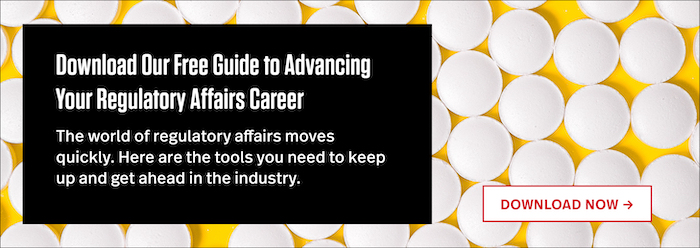Drug development is a lengthy and complex process. According to Thomas Koperniak, assistant teaching professor for Northeastern’s Master of Science in Regulatory Affairs program, it’s not uncommon for it to take more than 10 years to get a single drug to market.
This process demands extensive collaboration among both internal and external stakeholders. Cross-functional groups within an organization—including research and development (R&D), clinical research, quality assurance, manufacturing, supply chain, marketing, and sales—must work together to advance drug compounds from initial development to store shelves.
In each phase of development, drug companies are obligated to demonstrate the safety and efficacy of their drugs for human use. This requires near-constant correspondence between regulatory affairs departments and external health authorities through the delivery of many dossiers called regulatory submissions.
Download Our Free Guide to Advancing Your Regulatory Affairs Career
Learn how to navigate the discipline and accelerate your regulatory career.
What are Regulatory Submissions?
“A regulatory submission is a series of documents sent by a drug company to a health authority as evidence of compliance,” Koperniak says. “Laws and regulations influence many aspects of the drug development process. They impact how drug companies manufacture their drugs, design clinical trials, report safety findings, and create promotional material.”
Regulatory submissions begin in preclinical development, years before an investigational drug is given to a human subject. They are not only common throughout clinical development but—should the investigational drug become a marketed product—can continue as long as the product remains on the market.
Koperniak cites two major categories of regulatory submissions required to achieve and maintain approval for a drug:
- Investigational New Drug Applications (IND)
- New Drug Applications (NDA).
Here’s a closer look at what those categories entail.
Investigational New Drug Applications (IND)
The initial IND is a regulatory submission that allows a drug company to proceed to the clinical research phase. These applications can easily exceed 10,000 pages and include a variety of multidisciplinary information, including a wide range of non-clinical study reports, manufacturing information, and administrative reports.
Completing an IND is an enormous undertaking, but according to Koperniak, it’s just the beginning:
IND maintenance is carried out over the course of a drug’s lifetime through submission of a wide variety of IND amendments. For example, regulatory affairs professionals may need to collaborate with clinical colleagues to prepare a Protocol Amendment; with manufacturing or R&D to prepare an Information Amendment; with pharmacovigilance to prepare an IND Safety Report; or with all of these functions to prepare an Annual Report or updated Investigator’s Brochure.
By the time a company is conducting a Phase III clinical study, it would not be unusual for that organization to have submitted over 150 IND amendments to the FDA for a single compound being investigated for its safety and efficacy in treating or diagnosing a single indication.
New Drug Applications (NDA)
The initial NDA is a regulatory submission that allows a drug company to market, distribute, and sell its drug. These applications are similar in magnitude to the IND, and contain a variety of multidisciplinary information, including clinical and non-clinical study reports, manufacturing information, and administrative reports. Completing an NDA is also just the first step to getting clinically tested drugs to market. Koperniak says:
For a marketed drug to remain on the shelves, available for patients, it must be subject of an approved NDA. Regulatory affairs professionals allow their organizations to maintain approved NDAs through submission of NDA supplements. These regulatory submissions may involve periodic safety reports, label revisions, promotional material, new indications, manufacturing process changes, and annual reports.
Together, IND and NDA maintenance embody the multidisciplinary nature of drug development while underscoring the interconnectedness of cross-functional groups and the value of a skilled, experienced regulatory affairs department. Timely IND submission allows a potentially life-saving drug to be investigated in clinical research sooner—meaning the earlier collection of safety and efficacy data that are critical for an NDA. Efficient NDA submission allows for a clinically approved drug to reach patients sooner.
The Critical Role of the Regulatory Affairs Professional
The individuals responsible for preparing and submitting a potentially diverse array of regulatory submissions are known as regulatory affairs (RA) specialists. Throughout the lifespan of clinical development, these professionals hold the ultimate responsibility for maintaining the INDs and NDAs to allow the clinical research of drugs to continue in the United States.
RA specialists work and communicate cross-functionally with manufacturing, medical, clinical, non-clinical, and marketing divisions on a daily basis to incorporate their reports into submissions. Because the process involves so many departments, Koperniak says people in regulatory roles enjoy “uniquely broad perspectives on what’s happening in their company.”
Given the multi-faceted nature of the role, he says there are specific skill sets RA specialists should have to be successful in the profession. They should be:
- Strong communicators
- Expert organizers
- Skillful negotiators
- Cross-culturally sensitive
- Armed with vast regulatory knowledge
- Always learning
Here’s how those skills play out in the workplace.
Strong Communicators
The daily role of an RA specialist does not only involve collaboration with a wide range of internal functions. As the main liaisons between industry and government, RA specialists serve a key role in shaping their organization’s reputation in the eyes of global regulatory authorities. Excellent written and oral communication skills are vital to working in regulatory affairs and are skills RA specialists continually refine and strengthen over the span of an entire career.
To most effectively engage with internal departments during regulatory submission preparation, RA specialists need to clearly articulate the purpose of that submission, by explaining the relevant law, regulation, guidance, or guideline. Providing clear, well-justified regulatory guidance and designing compliant, implementable regulatory strategies strengthen the credibility of a regulatory affairs department within an organization.
Expert Organizers
Koperniak says organizational skills are imperative for RA specialists, who should possess a “meticulous attention to detail.” It’s their responsibility to orchestrate stakeholder meetings, gather information, compile hundred-page reports, and submit documents in accordance with the proper regulatory standards, all while keeping track of ever-evolving domestic and international regulations.
Skillful Negotiators
Regulatory submissions take place in a matrixed environment, across groups with divergent priorities and opinions. It’s an important part of the regulatory specialist’s job to articulate his or her business case and communicate to stakeholders why it’s necessary to continuously submit to the health authorities. RA professionals are tasked with building consensus among these groups in order to facilitate their participation in a timely submission process.
“Regulatory submissions are about a lot more than just memorizing and learning regulations,” Koperniak says. “They require the ability to apply that knowledge to real-world situations and to understand and communicate to stakeholders how each regulation may impact their role, their department, and the drug development process as a whole.”
Cross-Culturally Sensitive
There is a large international component to the regulatory submission process, as many Phase III studies involve sites participating from all over the world. Drug companies must comply with local regulatory authorities in each country where they desire to perform research or distribute their drug.
Local health authorities each have their own standards, regulations, processes, timelines, and review criteria. Juggling these variables can be a challenge. Drug companies often utilize local regulatory specialists from contract research organizations to help deconstruct the country’s regulatory framework, in each case working closely with international sponsors to ensure compliance. It’s crucial they remain culturally aware and communicate effectively on a global level.
Armed with Vast Regulatory Knowledge
RA specialists must stay up-to-date on emerging regulatory trends and be familiar with current regulations, guidances, and guidelines relevant to their company’s activities. Koperniak adds that being a regulatory specialist means doing “more than just organizing and sending documents; it demands strategic vision and strong project management.”
For instance, there are several expedited drug development pathways allowing for accelerated development and approval of certain drugs that are intended to treat a serious, unmet medical need. By understanding the qualifying criteria and benefits offered by such programs, and proactively engaging with internal departments to utilize them, RA specialists leverage their knowledge and leadership to provide their organization the opportunity to potentially bring its drug to market faster.
Always Learning
From development to launch, many operations in drug development are influenced by regulations. RA professionals must be mindful of the latest laws and regulations impacting their company’s activities. These activities—clinical data collection, safety reporting, promotional material dissemination, and product manufacturing—are as diverse as the kinds of drugs being developed and as wide-ranging as the countries and cultures where they are manufactured, tested, and sold.
RA professionals work in an environment saturated with change. Thus, regulatory professionals of all levels must continually learn on the job to adapt to changes in regulation. With ever-evolving laws, regulations, and responsibilities, there’s a growing demand for well-rounded professionals who not only understand current regulatory landscapes, but can also anticipate changes to those frameworks and their potential impact on multiple stakeholders.
What separates a good RA specialist from a great one, Koperniak explains, is an understanding of the procedures and standards expected by global regulatory authorities and the ability to consistently apply their feedback from prior submissions to future ones.
The Future of Regulatory Submissions
Koperniak says that regulatory frameworks and the submissions they demand will likely continue evolving in tandem with scientific advancements and technological achievements.
Personalized Medicine
Recent improvements in pharmacogenetics imply that future clinical trials may involve more targeted patient populations, potentially identified through genetic information. This has fueled proposals for new procedures for securing regulatory approvals needed to commence clinical trials in the European Union (EU). Currently, EU countries have their own FDA-equivalent health authority with distinct Clinical Trial Authorization (CTA) review timelines, procedures, and standards. This variability adds complexity in an already lengthy drug development process.
Centralized Information
Health authorities in the EU are now making a concerted effort to standardize the clinical regulatory landscape by introducing a single authorization and centralized, web-based portal through which CTA information will pass. While operational and administrative challenges have made implementation of this approach a challenge, this harmonization may eventually lead to fundamental changes in the way RA specialists prepare CTA applications in the future.
New Drug Discovery and Ethical Dilemmas
Advancements in our understanding of the molecular basis of diseases have also fueled the development of novel and effective drugs. Particularly in oncology, scientists have made therapeutic advancements in diseases with few alternatives for cancers associated with short survival times. As the unparalleled efficacy of these drugs in early clinical trials is revealed, questions are being raised on the ethics of applying the traditional drug development process for such promising investigational drugs.
Koperniak points out the ethical challenge:
While the FDA has a responsibility to protect consumers from adverse effects of experimental drugs, in cases where there is no other form of treatment, is it really ethical to keep a potentially life-saving drug in development—and out of reach of consumers—for almost a decade?
This kind of questioning has driven the creation of regulations allowing for expedited drug development pathways. For example, in 2012, the FDA introduced an expedited drug development pathway for “breakthrough” medications intended to treat serious conditions that show promising findings in early clinical studies. This pathway helps highly promising drugs make it to market faster, improves patient outcomes, and also serves as a competitive advantage to drug companies, who gain market exclusivity and save time and money on development.
To most effectively spearhead progress in the pharmaceutical industry, scientific advancements may need to be supplemented with regulatory evolution. Given the inherent link between science and regulation, it seems likely the FDA and global health authorities will continue introducing changes to the submission process that will shape the process of drug development.







Related Articles
4 Ways to Stay Competitive in Regulatory Affairs
Emerging Trends in Regulatory Affairs in 2022
How to Stay Updated on Regulatory Changes